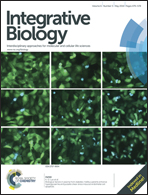Generation of 3D functional microvascular networks with human mesenchymal stem cells in microfluidic systems†
Abstract
The generation of functional microvascular networks is critical for the development of advanced in vitro models to replicate pathophysiological conditions. Mural cells provide structural support to blood vessels and secrete biomolecules contributing to vessel stability and functionality. We investigated the role played by two endothelium-related molecules, angiopoietin (Ang-1) and transforming growth factor (TGF-β1), on bone marrow-derived human mesenchymal stem cell (BM-hMSC) phenotypic transition toward a mural cell lineage, both in monoculture and in direct contact with human endothelial cells (ECs), within 3D fibrin gels in microfluidic devices. We demonstrated that the effect of these molecules is dependent on direct heterotypic cell–cell contact. Moreover, we found a significant increase in the amount of α-smooth muscle actin in microvascular networks with added VEGF and TGF-β1 or VEGF and Ang-1 compared to networks with added VEGF alone. However, the addition of TGF-β1 generated a non-interconnected microvasculature, while Ang-1 promoted functional networks, confirmed by microsphere perfusion and permeability measurements. The presence of mural cell-like BM-hMSCs coupled with the addition of Ang-1 increased the number of network branches and reduced mean vessel diameter compared to EC only vasculature. This system has promising applications in the development of advanced in vitro models to study complex biological phenomena involving functional and perfusable microvascular networks.


 Please wait while we load your content...
Please wait while we load your content...